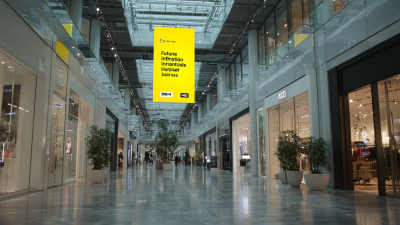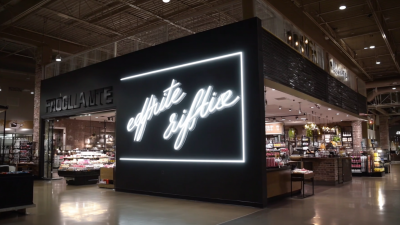



In today's competitive marketplace, effective communication is crucial for any business looking to thrive and attract customers. One of the most impactful yet often overlooked tools at your disposal is Indoor Signs. These versatile visual aids can guide patrons, enhance brand recognition, and create a welcoming atmosphere. With insights drawn from the booming $10 billion signage industry, this blog will explore five essential tips for leveraging Indoor Signs to boost your business. Whether you're a small retail store, a bustling restaurant, or a corporate office, understanding how to implement Indoor Signs strategically can lead to improved customer engagement and ultimately increase your bottom line. Join us as we uncover the powerful role Indoor Signs play in shaping your business success.

Indoor signs play a crucial role in enhancing brand recognition, with studies revealing that well-designed signs can increase customer attention by up to 83%. In the $10 billion signage industry, companies that invest in high-quality indoor signs experience a significant boost in customer engagement and retention. For instance, a report from the Sign Research Foundation indicates that nearly 76% of consumers say the quality of a business’s signage reflects the quality of their products or services. This clear correlation underlines the importance of investing in effective indoor signage.
To maximize the impact of indoor signs on your brand, consider the following tips. First, ensure that your signs are strategically placed where they can capture customer attention immediately. Positioning them in high-traffic areas can lead to a 30% increase in visibility. Second, leverage your signs to tell your brand story, using consistent colors and fonts that align with your overall brand identity. Research shows that consistent branding can increase revenue by 33%. Lastly, don’t underestimate the power of digital signage, which has been shown to attract 47% more attention compared to static signs, providing a dynamic way to communicate with your audience effectively.
| Metric | Statistic | Impact |
|---|---|---|
| Increase in Brand Recall | 70% | Improved customer recognition of brand |
| Purchase Decision Influence | 80% | Signs significantly affect buyer decisions |
| First Impressions | 60% | Visuals create initial customer perceptions |
| Navigational Assistance | 65% | Effective navigation improves customer experience |
| Sales Boost from Well-Designed Signs | 30% | Increased foot traffic leads to higher sales |
Indoor signage plays a crucial role in shaping consumer behavior and influencing purchase decisions. Studies show that effective signage can significantly enhance the shopping experience by providing clear information and guiding customers through a store. When strategically placed, indoor signs can highlight promotions, direct traffic to key areas, and create a cohesive brand narrative that resonates with shoppers. By capturing attention and delivering relevant messages, these signs can reduce decision-making time and increase the likelihood of spontaneous purchases.
Moreover, the psychological impact of indoor signage cannot be overlooked. Consumers often rely on visual cues to validate their choices, and well-designed signs can bolster their confidence in a brand. Eye-catching graphics and persuasive language can evoke emotions and create a connection with customers, making them more likely to engage with the product. This emotional engagement is essential, especially in a competitive marketplace, as it can transform a passerby into a paying customer. By investing in thoughtful indoor signage, businesses can not only inform but also inspire and persuade their audience, ultimately driving sales and fostering loyalty.
As businesses strive for innovation, the integration of digital signage has become increasingly essential in modern environments. According to a report by Grand View Research, the global digital signage market is expected to reach $31.71 billion by 2025, demonstrating the growing reliance on this technology. Digital signs offer dynamic, real-time content updates that not only engage customers but also enhance overall brand visibility. For instance, eye-catching video displays can boost customer retention rates by up to 90%, as reported by the Digital Signage Federation.
Furthermore, incorporating interactive digital signs can elevate the customer experience. A survey by Nielsen found that interactive signage increases customer engagement by 50% compared to static displays. Businesses utilizing digital technology can also track viewer interactions, allowing for data-driven marketing strategies that tailor content to audience preferences. In a world where immediacy and personalization drive consumer behavior, investing in digital signage is not merely an option but a critical component of future-ready business strategies.

Indoor signs play a crucial role in enhancing brand visibility and customer experience, while also representing a cost-effective marketing solution. By analyzing the return on investment (ROI) of indoor signage, businesses can appreciate the substantial impact that these signs have on both customer engagement and sales. For instance, clear and attractive signage can guide customers through a space, reducing confusion and enhancing the likelihood of making a purchase. This seamless navigation ultimately leads to higher customer satisfaction and repeat visits, confirming the value of signage in a retail environment.

Moreover, indoor signs can be tailored to suit various business needs, ensuring that investment aligns with specific marketing goals. The initial costs often pay off quickly due to increased foot traffic and sales conversions. Unlike other forms of advertising that require ongoing expenditure, such as digital ads, indoor signs provide a long-term solution. When businesses invest in quality indoor signage, they not only bolster their brand presence but also maximize their marketing budget and boost overall revenue, demonstrating the high ROI associated with this essential tool in the signage industry.
When it comes to utilizing indoor signs effectively, design and placement are paramount in maximizing visibility and engagement. First, consider the overall aesthetic of your space. Signs should complement the existing decor while standing out enough to catch the eye. Utilize bold colors and typography that align with your brand identity, ensuring that your message is clear and concise. The use of images or graphics can enhance understanding and retention of information, making it easier for customers to engage with your offerings.
In addition to design, strategic placement is crucial. Signs should be positioned at eye level and in high-traffic areas where customers can easily see them. Take note of the flow of movement within your space; placing directional signs along pathways and near points of interest can guide visitors effectively.
Furthermore, consider the use of digital signage to provide dynamic content that captures attention, allowing for updates and promotions that keep customers informed and engaged. By combining thoughtful design with strategic placement, indoor signs can significantly enhance the overall customer experience, driving engagement and ultimately boosting your business.






